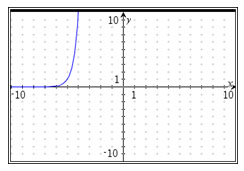In this section, you will learn what causes an exponential or logarithmic graph to shift right or left.
![]() Below are four functions, four graphs, and four descriptions of translations to the graphs of some exponential and logarithmic functions. Some functions, graphs, and descriptions have already been placed in the table. Place the remaining functions, graphs, and descriptions in the correct place.
Below are four functions, four graphs, and four descriptions of translations to the graphs of some exponential and logarithmic functions. Some functions, graphs, and descriptions have already been placed in the table. Place the remaining functions, graphs, and descriptions in the correct place.
Interactive popup. Assistance may be required.
The number that is being added or subtracted from x, the independent variable in the parent function, generates the horizontal translation.
Interactive popup. Assistance may be required.
The direction of the horizontal translation is the opposite of the sign of the parameter.
How does the horizontal translation of exponential and logarithmic functions compare to the horizontal translation of other functions, such as quadratic, square root, or rational functions?
Interactive popup. Assistance may be required.
The horizontal translation of all functions works the same, regardless of the function family. The direction of the translation is the opposite of the sign of the term being added or subtracted from the independent variable, x. The distance of the translation is the same as the number being added or subtracted from the independent variable, x.

Interactive popup. Assistance may be required.
The horizontal shift is 9 units to the right.

Interactive popup. Assistance may be required.
The graph of h(x) would be shifted 9 units to the right of the graph of p(x).


Interactive popup. Assistance may be required.
k(x) = 10x changed to p(x) = 10x+5